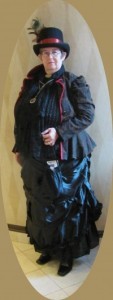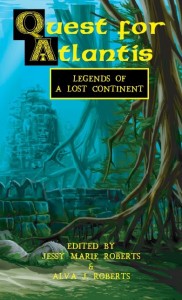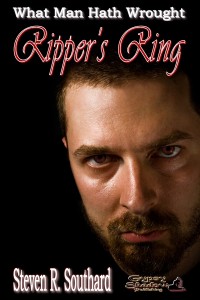Today I’m pleased to interview another author from the anthology Hides the Dark Tower, namely Peter Schranz.
 Peter maintains a quirky website and has two published short story collections, Astonishing Tales of the Sea and It Spits You Out. Three of his stories were published in Breadcrumbs magazine here, here, and here. Mirror Dance published his story “Pond Wife,” and Deimos published his story “Elizabeth.”
Peter maintains a quirky website and has two published short story collections, Astonishing Tales of the Sea and It Spits You Out. Three of his stories were published in Breadcrumbs magazine here, here, and here. Mirror Dance published his story “Pond Wife,” and Deimos published his story “Elizabeth.”
Here’s the interview:
Poseidon’s Scribe: How did you get started writing? What prompted you?
Peter Schranz: I remember considering the various options and deciding that writing required the fewest resources. If I wanted to paint, I’d have to buy paint, and if I wanted to play the drums I’d have to buy drums, but I already had a computer with a word processor, and I was already literate, so writing felt like the path of least resistance. I was twelve or so when I realized that, but now I think there was probably more going on; my mother is a linguist and she convinced me of language’s significance pretty early on. It would surprise me if that played no part at all in my decision to start writing.
P. Scribe: Who are some of your influences? What are a few of your favorite books?
P. Schranz: I like the German-writers, such as Heinrich von Kleist and his admirer Kafka, though I’ve only read them in translation. Baudelaire, Plath, and Katherine Ciel are my favorite poets. I think Plath’s prose is underappreciated; last year I discovered a copy of her journals and read it twice in a row. I learned from the writing of David Wallace and von Kleist to delight in complicated, subordinate clause-bedecked sentences, though I’ll stop short of commenting one way or the other on those I write myself. I thought that The Broom of the System was great and I seek to copy off of it.
It’s not narrative, but I liked the Compendium on Reality by the Buddhist monk Santaraksita, where I saw higher degrees of abstraction than ever before or since.
Recently I’ve become a fan of Kristine Ong Muslim, who wrote a series of very scary poems called “the Strangers,” which, if you dare, you can easily find online.
P. Scribe: What is your primary genre, and how did you become interested in it?
P. Schranz: I like to write speculative fiction that cleaves as closely to realism as possible. Realism seems like fiction’s default to me, and for every speculative flight of fancy I pile onto a story, I like to pile on a tempering, realistic element, too. My story “Pond-Wife” in Mirror Dance Magazine is about a woman who hunts monsters, and she has to see a psychiatrist because constant violent confrontations with monsters give people brain-problems.
P. Scribe: You’ve had a couple of collections of your stories published: It Spits You Out, And Twelve More Stories To Rub Your Chin To and Astonishing Tales Of The Sea. The common feature of the second collection is obvious, but what is the shared attribute (if any) in the stories within It Spits You Out?
P. Schranz: If it’s honesty you’re after, Steve, then I should say that I decided, since Astonishing Tales of the Sea was so obviously thematic, that the stories in It Spits You Out could get away with total themelessness. Afterwards, though, it seemed like all the stories were about either surprisingly alive things or things that are neither alive nor dead. “Eel-Thing” and “Public Napkin” for example are about diseases, which I suppose are alive for all the same reasons that, say, weiner dogs are alive, not that I’m a biologist or anything. Then there’s “The House That Fed On Blood,” a story with a spoiler in its title, and “Eve and Erling,” which is about ghouls. So the theme is loose, retrospectively forced, and accidental, but still present, sort of. Also the stories in It Spits You Out are all kind of silly.
P. Scribe: Please tell us a little about your story within ![Pageflex Persona [document: PRS0000039_00001]](https://stevenrsouthard.com/wp-content/uploads/2015/10/HidesTheDarkTower-DigitalCover-FINAL2-200x300.jpg) Hides the Dark Tower, “Tower of the Sea Witch.”
Hides the Dark Tower, “Tower of the Sea Witch.”
P. Schranz: It was in Astonishing Tales of the Sea first, but the version that appears in Hides the Dark Tower has its hair combed a little bit thanks to its thoughtful editors. The story is about a woman who wants closure so badly that she would rather it be guaranteed than satisfying.
P. Scribe: Where do you get the ideas for your stories?
P. Schranz: Overall I just get my ideas from what I read, but often there’s some other less straightforward element involved. “Tower of the Sea Witch” started when I went to the beach and saw an oil rig or something on the horizon. I wondered if anyone was on it and how they got there.
I like to keep something to write on by my bed, and if I wake up after a dream, to tell myself that it will escape from all human consciousness forever unless I turn the light on and write it down that very second. If I hadn’t done so last night, for example, humanity could never answer this very important question that I found in my journal when I awoke: “What if, when they see him in the sixties, they see a bird, or a bird unto glory?” My brain always whispers ‘go to sleep, you oaf; you’ll remember,’ or ‘you’ll be wasting both ink and sack-time if you write that down,’ but my brain is lying to me about at least one of those assertions.
P. Scribe: What are the easiest, and the most difficult, aspects of writing for you?
P. Schranz: The easiest aspect is coming up with the general phantom of a story’s plot. Making the plot intricate and precise is difficult, as is determining whether a part of the story ought to be excised or not; whether a draft is the last draft or the second-to-last; giving the characters distinct voices; making their goals, hopes, and habits realistic and 3D; actually improving the story through subsequent drafts and not just indulging in pencilwork, like changing ‘she mumbled’ to ‘she murmured,’ which covers about ninety eight percent of my revising decisions; and determining whether I need to spell something out and run the risk of making the story too obvious, or trust the subtext and run the risk of making the story a complete bafflement. It’s no walk in the park to pace a story well, either.
P. Scribe: In what way is your fiction different from that of other authors in your genre?
P. Schranz: I’m not sure it is any different, except very vacuously: I don’t write a lot of stories about dragons or robots or dwarves or spaceships (except for my silly game, “A Spaceship You Go On!”), but I do write a lot of stories about alien corpses. My plan is to take every single corpse ever featured in the horror genre, remove it, and replace it with the corpse of an alien.
P. Scribe: What is your current work in progress? Would you mind telling us a little about it?
P. Schranz: I’m revising a story about all these pill-sized coffins full of little tiny alien skeletons, and mulling over a sequel where people think the coffins are the grains of some kind of food.
Poseidon’s Scribe: What advice can you offer aspiring writers?
Peter Schranz: Memorize twenty poems.
Thank you, Peter! Readers of my blog can find out more about Peter Schranz at his website, and on Facebook.
Poseidon’s Scribe










![Pageflex Persona [document: PRS0000039_00001]](https://stevenrsouthard.com/wp-content/uploads/2015/10/HidesTheDarkTower-DigitalCover-FINAL2-683x1024.jpg)
